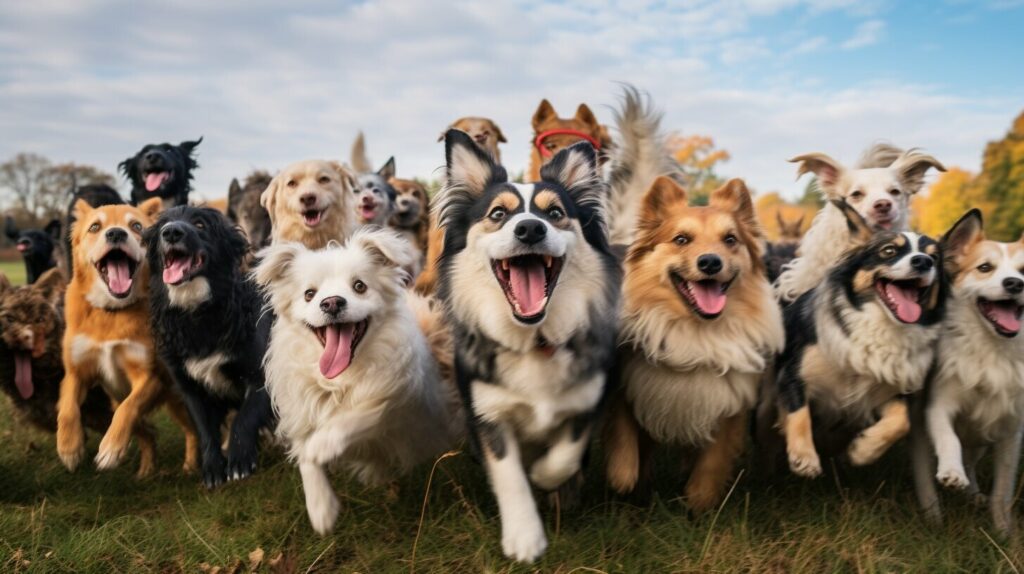As a dog owner, one of your primary responsibilities is to ensure your pet does not pose a threat to others. Dog biting incidents can have serious consequences, resulting in injury, trauma, or even legal action against you. Understanding why dogs bite and how to prevent it can help keep your pet and community safe.
Dog aggression can stem from various factors such as fear, territoriality, or possessiveness. Early socialization and appropriate training techniques can help prevent aggressive behaviors from developing in your pet. Knowing how to recognize warning signs of aggression and creating a safe environment can also be critical in preventing dog bites.
Key Takeaways:
- Dog biting can have serious consequences, including legal action.
- Understanding the factors that contribute to dog aggression is essential for prevention.
- Early socialization and appropriate training techniques can help prevent aggressive behaviors.
- Creating a safe environment and learning to recognize warning signs of aggression can also be critical in preventing dog bites.
The Nature of Dog Behavior
Understanding dog behavior is the key to addressing dog biting problems. A dog’s behavior is influenced by a variety of factors including genetics, environment, and experiences. It’s important to recognize that any dog, regardless of breed, could exhibit aggressive behavior, and it’s the owner’s responsibility to identify and prevent it.
Fear is a common cause of dog biting problems. Dogs may perceive certain situations or environments as threatening, causing them to feel anxious or afraid. In turn, they may exhibit aggression as a means of self-defense. Territoriality and possessiveness are also common triggers for dog bites. Dogs may become possessive of their food or toys, or protective of their home and family.
Early socialization is crucial in preventing dog biting problems. Dogs that are introduced to a variety of people, animals, and environments during a critical developmental period (between three and fourteen weeks old) are more likely to develop positive behaviors towards humans and other animals. Proper socialization can also help reduce fear and anxiety, leading to more confident and well-adjusted dogs.
The Importance of Proper Training
Proper training is another important factor in preventing dog biting problems. Positive reinforcement methods, such as rewarding good behavior with treats or praise, can be effective in modifying behavior and discouraging biting. Obedience training, which teaches dogs basic commands such as “sit” and “stay,” can also help establish a clear hierarchy and reduce the likelihood of aggressive behaviors.
If your dog exhibits biting behaviors, it’s important to seek professional help. A qualified trainer or behaviorist can assess your dog’s behavior and provide customized solutions to address the underlying causes of the aggression.
Conclusion
Understanding dog behavior is the key to preventing dog biting problems. By recognizing the underlying causes of aggression, properly socializing your dog, and providing appropriate training, you can help ensure a safe and harmonious relationship between your pet and the community.
Recognizing Warning Signs of Aggression
Managing dog aggression and understanding how to stop dogs from biting requires an acute awareness of their body language and behavior. As a responsible pet owner, you need to recognize the signs of impending aggression so that you can take preventive measures and avoid potential bites.
Dogs communicate their feelings through a variety of physical and behavioral cues that you need to be familiar with. Signs of aggression may include:
- Baring teeth
- Growling or snarling
- Stiff posture or rigid body language
- Aggressive barking
- Pinned back ears
- Lunging or charging at people or other animals
It’s essential to act immediately when you notice any of these warning signs. Start by removing your dog from the situation or removing the threat if possible. Keep a safe distance and don’t approach your pet if it’s exhibiting aggressive behavior. Avoid direct eye contact and sudden movements that may trigger further agitation.
If you notice repeated episodes of aggressive behavior in your dog, it’s important to seek professional help. A certified behaviorist or trainer can assess your pet’s behavior and recommend training techniques that can help manage their aggression and stop them from biting.
Early Socialization: The Key to Preventing Dog Bites
It’s no secret that dogs are social creatures, but not all dogs are naturally well-behaved. If you do not teach your dog appropriate behaviors from a young age, they may develop undesirable behaviors such as biting. Therefore, early socialization is essential in preventing dog biting problems.
Dog behavior can be shaped by their early experiences. Therefore, it is crucial to expose puppies to various environments, people, and other animals. This will help them learn how to interact positively, develop self-confidence, and prevent fear-based aggression. Socialization should start as early as possible, ideally between the ages of 3 and 14 weeks.
| How to Socialize Your Puppy: | Why |
|---|---|
| Take them for daily walks in your neighborhood | Helps them meet different people and other dogs |
| Take them to a dog park | Provides opportunities for interactive playtime with other dogs |
| Introduce them to different kinds of people | Helps them feel comfortable around different kinds of people |
| Expose them to different sounds and smells | Prepares them for unusual environmental stimuli |
However, socialization does not end with puppyhood. It is a lifelong process that should continue through various stages of your dog’s life. As dogs grow and mature, their socialization needs change accordingly. Continued exposure to different situations and people will keep them comfortable, friendly, and confident.
In conclusion, early socialization is essential in preventing dog biting problems. By socializing puppies at a young age, you can nurture positive behavior and prevent aggressive tendencies such as biting. Remember that socialization should be a continual process and should be tailored according to your pup’s needs.
Dog Bite Prevention in the Home
Preventing dog bites starts in the home, where most incidents occur. By creating a safe environment for your dog, you can greatly reduce the risk of aggression. Here are some tips to help you manage your dog’s behavior:
| Tip | Description |
|---|---|
| Secure Containment | Make sure your dog is safely contained when you are not home. Use a crate or secure area to keep your dog from roaming free, which could lead to territorial behavior or escape attempts. |
| Proper Supervision | When you are home, supervise your dog closely and intervene if necessary. Keep an eye out for signs of tension or aggression, and redirect their attention if needed. |
| Managing Resources | Food, toys, and other resources can trigger possessive behavior in dogs. Establishing clear rules and boundaries around these items can help prevent guarding behavior and reduce the risk of biting. |
| Establishing Rules and Boundaries | Make sure your dog understands the rules of the household, including boundaries around furniture and personal space. Consistency is key to establishing good behavior. |
Remember, managing your dog’s behavior is your responsibility as a pet owner. By taking proactive steps to prevent dog bites in the home, you can ensure the safety and well-being of your furry friend and the people around you.
Training Techniques for Curbing Dog Biting
If you’re struggling with a dog that has a biting problem, it’s essential to address the issue as soon as possible. Not only can biting behaviors be dangerous for humans and other animals, but they can also result in legal consequences for the dog owner. Here are some effective training techniques you can use to discourage biting and promote positive behavior:
Positive Reinforcement
Positive reinforcement is a training approach that rewards desired behaviors with treats, praise, or affection. You can use this technique to shape your dog’s behavior and encourage them to be more gentle and calm. For instance, when your dog interacts appropriately with other dogs or people, reward them with a treat or a favorite toy. Conversely, if your dog starts to growl or snap, remove them from the situation and withhold treats or attention. Over time, your dog will learn that calm and friendly behaviors are more rewarding than aggressive ones.
Obedience Training
Another effective training technique is obedience training, which teaches your dog basic commands such as “sit,” “stay,” and “come.” By mastering these commands, your dog will learn to obey your instructions and behave appropriately in different situations. This can also help them gain self-control and reduce biting tendencies. For example, if your dog starts to growl or snap, you can use the “stay” command to keep them in place and prevent them from biting.
Professional Assistance
In some cases, professional help may be necessary to address dog biting problems. A qualified dog trainer or behaviorist can assess your dog’s behavior and suggest appropriate training techniques based on their specific needs. They can also help you understand the underlying reasons behind your dog’s aggression and provide guidance on managing it. If you’re having trouble training your dog on your own, seeking professional assistance may be a crucial step towards curbing biting behaviors and ensuring the safety of those around your dog.
By using these training techniques and being consistent and patient, you can help your dog overcome their biting tendencies and develop positive behaviors. Remember, a well-trained and socialized dog is not only a happier and healthier pet, but also a safer and more enjoyable companion for you and others.
Seeking Professional Help for Dog Aggression
If your dog’s aggressive behavior persists despite your efforts to address it, it may be time to seek professional help. While some biting behaviors can be corrected with proper training, others may stem from deep-seated psychological or medical issues that require specialized intervention. If you are unable to manage your dog’s aggression on your own, don’t hesitate to seek the assistance of a qualified dog trainer or behaviorist.
Dog trainers and behaviorists have the experience and expertise to identify the underlying causes of your dog’s biting behavior and develop a customized plan of action to modify it. They can provide professional guidance on proper socialization techniques, management strategies, and positive reinforcement methods to discourage biting and encourage good behavior.
When seeking professional help, it’s important to choose a qualified trainer or behaviorist who has experience working with dogs exhibiting aggressive behavior. Look for someone who uses positive reinforcement methods rather than punishment-based techniques, which can exacerbate aggressive tendencies. Don’t be afraid to ask for references and proof of certification or accreditation.
In addition to working with a professional, it’s crucial to continue enforcing good behavior and reinforcing positive interactions with your dog at home. Consistency is key, and your efforts to manage your dog’s aggression should be ongoing and thorough.
Remember, managing dog aggression requires patience, dedication, and a deep understanding of dog behavior. With the right training, socialization, and management techniques, you can help your dog overcome its aggressive tendencies and build a happy, healthy relationship with your furry friend.
Understanding Liability and Legal Considerations
As a dog owner, it is important to understand the legal implications of dog bites and the potential consequences of dog aggression. Dog bites can result in serious injuries and even death, making it essential to take preventive measures to ensure the safety of both your pet and others around you.
In the United States, laws regarding dog bites vary from state to state. However, in general, dog owners are held liable for any harm caused by their pets. This means that if your dog bites someone, you can be sued for damages, and you may be required to pay for medical bills, lost wages, and other expenses resulting from the incident.
It is therefore crucial to have liability insurance in case of a dog bite. Most homeowners’ insurance policies include liability coverage for dog bites, but it’s important to check with your insurance provider and ensure that your policy includes this coverage.
Depending on the state you live in, there may be breed-specific legislation that imposes additional requirements on owners of certain dog breeds. For instance, some states require owners of pit bulls to carry a higher amount of liability insurance or to keep their dogs muzzled in public places.
Aside from these legal considerations, being a responsible dog owner also means taking steps to prevent dog aggression in the first place. This includes proper training, socialization, and supervision to ensure that your dog is well-behaved and not a danger to others.
In summary, understanding the legal implications of dog bites and taking steps to prevent dog aggression is crucial for all dog owners. By being responsible and proactive, you can ensure the safety of your pet and those around you, and avoid potential legal and financial consequences.
Educating Children about Dog Safety
Dogs can be wonderful companions for children, but it’s important to teach them how to interact safely with dogs to prevent bites. In fact, according to the Centers for Disease Control and Prevention, children are more likely to be bitten by dogs than adults.
Here are some tips for educating your child about dog behavior and safety:
- Always ask for permission. Teach your child to always ask the dog’s owner if they can pet the dog before approaching. Not all dogs are friendly, and some may feel threatened or scared by strangers.
- Respect boundaries. Encourage your child to respect a dog’s space and avoid getting in their face. Hugging, kissing, or pulling on a dog’s tail or ears can be perceived as a threat and trigger a defensive response.
- Recognize warning signs. Teach your child to recognize when a dog is feeling uncomfortable or scared, such as stiff body posture, growling, or baring teeth. Instruct them to back away slowly and not to run or scream, which could escalate the situation.
- Never disturb a dog that is eating or sleeping. Dogs can be protective of their resources and may feel threatened if disturbed while eating or sleeping.
- Don’t approach unfamiliar dogs. Teach your child to avoid approaching unfamiliar dogs, especially those that are restrained or tied up. These dogs may be feeling vulnerable and defensive, and can react unpredictably in these situations.
By educating your child about dog behavior and safety, you can help prevent dog bites and promote a positive relationship between children and dogs.
Conclusion
In conclusion, it is crucial to understand the nature of dog behavior and recognize warning signs of aggression to prevent dog bites. Early socialization and appropriate training techniques play a significant role in curbing biting habits in dogs. As a responsible dog owner, it is your duty to create a safe environment at home and seek professional help when necessary to manage dog aggression.
It is also important to understand the legal implications of dog bites and take necessary precautions to protect oneself and others from potential harm. Educating children about dog safety is another important aspect of preventing dog bites and ensuring a harmonious coexistence between children and dogs.
Remember, preventing dog bites starts with you!
By understanding canine behavior, early socialization, and appropriate training techniques, you can ensure the safety and well-being of both your pet and the community. Take the necessary steps to prevent dog bites and be a responsible and caring dog owner.
FAQ
Q: How can I prevent dog bites?
A: Preventing dog bites involves understanding canine behavior, early socialization, and appropriate training techniques. It is important to recognize warning signs of aggression, create a safe environment at home, and seek professional help if necessary. Educating children about dog safety is also crucial in preventing bites.
Q: What are the reasons behind dog biting behavior?
A: Dog biting behavior can be influenced by factors such as fear, territoriality, possessiveness, and lack of socialization. Understanding these underlying reasons can help address and prevent aggressive tendencies in dogs.
Q: How can I identify warning signs of aggression in my dog?
A: It is important to be able to recognize warning signs of potential aggression in dogs. This includes observing their body language and behavioral cues, such as growling, snarling, raised hackles, and rigid posture. Being aware of these signs allows owners to take appropriate preventive measures.
Q: How does early socialization help prevent dog bites?
A: Early socialization plays a crucial role in preventing dog bites. Exposing puppies to various social situations and ensuring positive interactions with humans and other animals helps them develop appropriate behaviors and reduces the risk of aggressive tendencies later in life.
Q: What can I do to create a safe environment at home to prevent dog bites?
A: Creating a safe environment at home involves secure containment, proper supervision, managing resources, and establishing rules and boundaries. These measures help reduce the risk of aggression and protect both the dog and the people in the household.
Q: What training techniques can help curb dog biting?
A: Effective training techniques for addressing dog biting problems include positive reinforcement methods, obedience training, and seeking professional assistance if needed. Consistency and patience are key in modifying behavior and discouraging biting.
Q: When should I seek professional help for dog aggression?
A: Professional help may be necessary to manage dog aggression in certain situations. If efforts to address the behavior on your own are not successful, it is important to seek out qualified trainers or behaviorists who can assess the underlying causes and provide appropriate guidance and support.
Q: What are the legal considerations surrounding dog bites?
A: Dog bites can have legal implications, and it is important for dog owners to understand their responsibilities. This includes obtaining liability insurance, being aware of breed-specific legislation, and practicing responsible ownership to protect themselves and others from potential harm.
Q: How can I educate children about dog safety?
A: Educating children about dog safety is essential in preventing bites. Providing age-appropriate guidelines for interacting with dogs, teaching respect for animals, and helping children recognize warning signs of aggression contribute to a harmonious coexistence between children and dogs.



